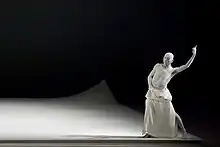Ushio Amagatsu
Ushio Amagatsu (天児 牛大, Amagatsu Ushio, born 1949 in Yokosuka, Kanagawa) is a Japanese choreographer known as the leader of the Butoh dance group Sankai Juku, which he founded in 1975. He is the artistic director, choreographer and a dancer of Sankai Juku. He was also a co-founder of the seminal Butoh collective Dairakudakan in 1972. All Sankai Juku works since 1982 were premiered at and co-produced by Théâtre de la Ville, Paris. Sankai Juku has performed at more than 40 countries, 700 cities worldwide. Since 1997, he works as opera director as well.

Biography
- In 1949, born in Yokosuka, Japan
- In 1972, co-founded Dairakudakan
- In 1975, founded Sankai Juku
- In 1980, did his first performance abroad at the Nancy International Festival in France
- In 1989, appointed to the artistic director of the Spiral Hall in Tokyo.
- In 1992, presided the Jury of the International Meeting of Dance of Bagnolet.
- from 2002 to 2005, president of judge for "Toyota Choreography Award"
Works
- In 1977, created Amagatsu Sho (Homage to Ancient Dolls)
- In 1978, created Kinkan Shonen (Kumquat Seed)
- In 1979, created Sholiba
- In 1981, created Bakki, which premiered at Festival d'Avignon, France
- In 1982, created Jomon Sho (co-produced by and premiered at Théâtre de la Ville, Paris)
- In 1984, created Netsu no Katachi
- In 1985, direction and choreography for the photo book Luna
- In 1986, created Unetsu - The Egg stands out of Curiosity
- in 1987, direction and choreography for the photo book The Egg stands out of Curiosity
- In 1988, created Shijima - The Darkness Calms Down in Space
- In 1988, created Fushi on the invitation of Jacob's Pillow Foundation, in the U.S., music by Philip Glass, premiered at Spiral Hall, Tokyo.
- In 1989, directed Apocalypse (1989), music by Takashi Kako, dance by Ismael Ivo, premiered at Spiral Hall, Tokyo.
- In 1989, directed and choreographed Fifth-V (1990) for six American dancers, premiered at Spiral Hall, Tokyo.
- In 1991, created Omote - The Grazed Surface
- In 1993, created Yuragi - In a Space of Perpetual Motion
- In 1995, created iyomeki - Within a Gentle Vibration and Agitation
- In February 1997, directed Bartok's opera Bluebeard's Castle, conducted by Péter Eötvös for the Tokyo premiere.
- In 1997, directed a concert of Takashi Kako Iro wo Kasanete, at Park Tower Hall, Tokyo.
- In 1998, created Hibiki - Resonance from Far Away
- In March 1998, at Opéra National de Lyon, France, he directed Péter Eötvös' opera Tri sestry (Three Sisters, world premiere). The opera was also presented in the 2001/02 season at Théâtre du Châtelet in Paris, at Théâtre Royal de la Monnaie in Brussels, and at the 2002 Wiener Festwochen in Austria.
- In 2000, created Kagemi - Beyond the Metaphors of Mirrors
- In 2003, created Utsuri - Virtual Garden
- In 2005 re-created Kinkan Shonen. Amagatsu's solo parts of the original version are performed by three young dancers.
- In 2006, created Toki - A moment in the weave time
- In 2008, created Tobari - As if in an inexhaustible flux
- In 2008, created Utsushi, which is a collage from past works. Amagatsu doesn't dance in this one.
- In 2010, created Kara・Mi - Two Flows
Awards and recognition
- In 1992, Amagatsu was awarded the "Chevalier de l'Ordre des Arts et des Lettres" by the French Ministry of Culture.
- In 1998, Péter Eötvös’s opera "Three Sisters", which directed by Amagatsu, received "Prix du Syndicat de la critique, France".
- In February 2002, "Hibiki" won the 26th Laurence Olivier Award for Best New Dance Production.
- In March 2004, Amagatsu was awarded "Geijutu Sensho Prize (Art Encouragement Prize)", by the Minister of Education, Culture, Sports, Science, and Technology of Japan, for his outstanding artistic achievement.
- In 2007, "TOKI" received "Grand Prix of the 6th The Asahi Performing Arts Awards" and Sankai Juku received "Kirin Special Grant for Dance."
- In 2008, Péter Eötvös’s opera "Lady Sarashina", which directed by Amagatsu, received "Prix du Syndicat de la critique, France" again.
Books, photo books and other references
- "Luna" (photo book) directed and choreographed by Ushio Amagatsu, feat. Sayoko Yamaguchi and Sankai juku.
- "The Egg stands out of Curiosity" (photo book) directed and choreographed by Ushio Amagatsu
- Interviews with Ushio Amagatsu: Japan Foundation, Performing Arts Network Japan
External links
This article is issued from Wikipedia. The text is licensed under Creative Commons - Attribution - Sharealike. Additional terms may apply for the media files.